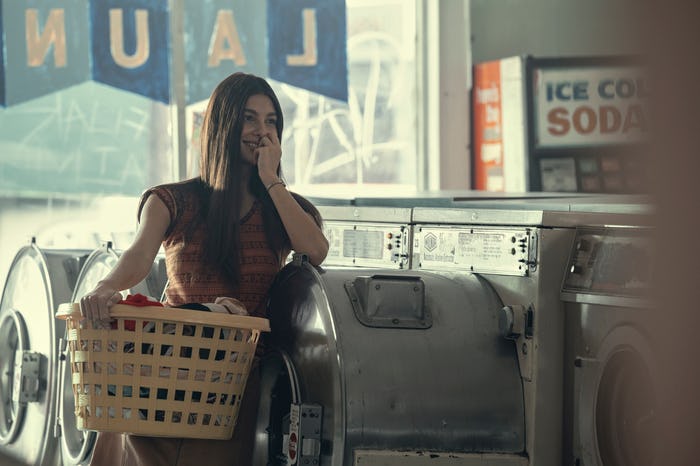Entertainment

'Daisy Jones & The Six' Asks Whether Hot Famous Women Can Have It All
We may be tired of the question, but as the new Amazon Prime show argues, the question isn’t tired of us.
Women may be tired of being asked whether they can ever really "have it all," but Daisy Jones & The Six tries to breathe new life into the question.
Based on the 2019 novel by Taylor Jenkins Reid, Amazon Prime's new series tells the story of a fictional rock band — who are based loosely on Fleetwood Mac — and their rapid, turbulent, drama-filled rise to fame. In the show, we meet four women whose stories explore different versions of modern womanhood, and the ways each character grapples with the desire to "have it all."
For the women in Daisy Jones, the question of whether they can "have it all" doesn't seem to be at the forefront of most of their minds yet, at least not explicitly. Few of them actually want "it all" anyway, but the question still hangs above them, just like it does us. In 2019, Glamour reported that "a shocking 0% of Gen Z Glamour readers believe that feminism means women ‘having it all.'" As Marie-Claire Chappet wrote at the time, "Younger generations, who have grown up with working mothers as the norm, have swiftly realized that ‘having it all’ actually translates as ‘doing it all’ — and that’s not OK."
But this TV show takes place in the late '70s. At its center is the Stevie Nicks-inspired Daisy Jones, the band's charismatic, slightly manic lead singer. She is passionate about songwriting and performing, and, as it turns out, she has an innate, almost otherworldly talent for it. Daisy represents a sort of Gen Z approach to the question of "can women have it all" in that she flat-out refuses to operate within its restrictive parameters. In fact, the idea of even asking her the question seems ludicrous. She is a reminder that for many women, the question is reductive and, frankly, irrelevant.
But her experience isn't universal. The universe of Daisy Jones knows that the question, tired as it is, still has a way of wheedling itself into our lives.
Ultimately, the show reminds us why striving to "have it all" can mean succumbing to "doing it all" — and for most women, this simply isn't a goal worth having.
The band's other female member, pianist Karen Sirko, is far more grounded and focused than Daisy. While she also makes the most of the excesses of her glamorous rock 'n' roll life, she has a plan. She has a career. She has success. When she gets her first paycheck, for instance, she invests in the stock market — "obviously," she says. Karen has her head on her shoulders and she knows what fulfillment looks like to her. But when she begins a relationship with Graham, the band's guitarist, she comes face to face with the fact that his version of a successful life looks a little different from hers. As a man in the world of 1970s rock 'n' roll, it's far easier for him to envisage a future that holds both superstardom and weekend afternoons with the kids, because he'll have to do less. Karen begins to realize that, in her world, having a family would mean sacrificing her imagined future.
And then there's Camila. Camila is the wife of frontman Billy. Her main dream revolves around having a family. Interestingly, she is a stay-at-home mother in Reid's novel, and is largely content to have a life that revolves around her family. In the show, however, Camila is given a slightly more nuanced arc. As a freelance photographer, she has her own private passions and career ambitions. However, as the show demonstrates, to have this "all," Camila also has to do a whole lot. Billy is a rock star and rock stars are busy, so Camila takes on the lion's share of the child-rearing. She makes their home nice. Plus, she brings her daughter to the sets of her photo shoots.
And finally, there is Simone, Daisy's best friend. A talented disco singer, Simone doggedly pursues a career in the music industry. When she falls in love with another woman, she is forced to choose between love and career. She ultimately finds a way to create a future that has her own version of "it all" — even though this "all" looks vastly different from the stereotype.
The show offers no moral judgment of these women or their choices, but instead gives us a blunt look at the realities they face. It doesn't claim that having more than one thing is impossible, but it also doesn't sugarcoat the reality of the female experience. Ultimately, the show reminds us why striving to "have it all" can mean succumbing to "doing it all” — and for most women, this simply isn't a goal worth having.
Meg Walters is a freelance journalist and features writer. Raised in Canada and based in South East London, Meg frequently writes about culture and lifestyle. Her work has appeared in GQ, Cosmopolitan, i-D, Refinery29, Shondaland, and Stylist, amongst other publications. When not writing, Meg is probably daydreaming about travel, rewatching an old rom-com with a glass of wine, or wasting time on Twitter.
This article was originally published on